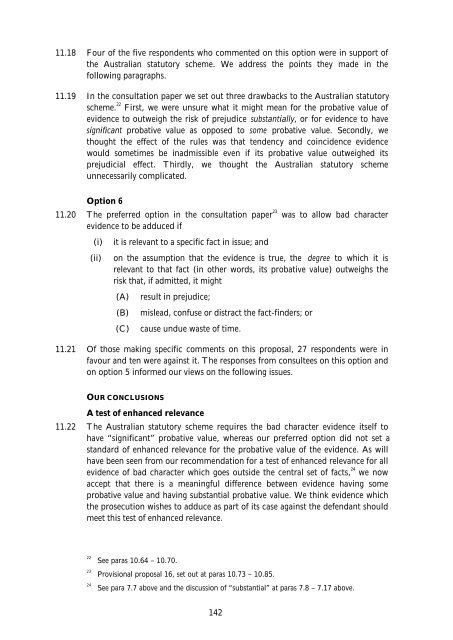Evidence of Bad Character in Criminal ... - Law Commission
Evidence of Bad Character in Criminal ... - Law Commission
Evidence of Bad Character in Criminal ... - Law Commission
You also want an ePaper? Increase the reach of your titles
YUMPU automatically turns print PDFs into web optimized ePapers that Google loves.
11.18 Four <strong>of</strong> the five respondents who commented on this option were <strong>in</strong> support <strong>of</strong><br />
the Australian statutory scheme. We address the po<strong>in</strong>ts they made <strong>in</strong> the<br />
follow<strong>in</strong>g paragraphs.<br />
11.19 In the consultation paper we set out three drawbacks to the Australian statutory<br />
scheme. 22 First, we were unsure what it might mean for the probative value <strong>of</strong><br />
evidence to outweigh the risk <strong>of</strong> prejudice substantially, or for evidence to have<br />
significant probative value as opposed to some probative value. Secondly, we<br />
thought the effect <strong>of</strong> the rules was that tendency and co<strong>in</strong>cidence evidence<br />
would sometimes be <strong>in</strong>admissible even if its probative value outweighed its<br />
prejudicial effect. Thirdly, we thought the Australian statutory scheme<br />
unnecessarily complicated.<br />
Option 6<br />
11.20 The preferred option <strong>in</strong> the consultation paper 23 was to allow bad character<br />
evidence to be adduced if<br />
(i) it is relevant to a specific fact <strong>in</strong> issue; and<br />
(ii) on the assumption that the evidence is true, the degree to which it is<br />
relevant to that fact (<strong>in</strong> other words, its probative value) outweighs the<br />
risk that, if admitted, it might<br />
(A) result <strong>in</strong> prejudice;<br />
(B) mislead, confuse or distract the fact-f<strong>in</strong>ders; or<br />
(C) cause undue waste <strong>of</strong> time.<br />
11.21 Of those mak<strong>in</strong>g specific comments on this proposal, 27 respondents were <strong>in</strong><br />
favour and ten were aga<strong>in</strong>st it. The responses from consultees on this option and<br />
on option 5 <strong>in</strong>formed our views on the follow<strong>in</strong>g issues.<br />
OUR CONCLUSIONS<br />
A test <strong>of</strong> enhanced relevance<br />
11.22 The Australian statutory scheme requires the bad character evidence itself to<br />
have “significant” probative value, whereas our preferred option did not set a<br />
standard <strong>of</strong> enhanced relevance for the probative value <strong>of</strong> the evidence. As will<br />
have been seen from our recommendation for a test <strong>of</strong> enhanced relevance for all<br />
evidence <strong>of</strong> bad character which goes outside the central set <strong>of</strong> facts, 24 we now<br />
accept that there is a mean<strong>in</strong>gful difference between evidence hav<strong>in</strong>g some<br />
probative value and hav<strong>in</strong>g substantial probative value. We th<strong>in</strong>k evidence which<br />
the prosecution wishes to adduce as part <strong>of</strong> its case aga<strong>in</strong>st the defendant should<br />
meet this test <strong>of</strong> enhanced relevance.<br />
22 See paras 10.64 – 10.70.<br />
23 Provisional proposal 16, set out at paras 10.73 – 10.85.<br />
24 See para 7.7 above and the discussion <strong>of</strong> “substantial” at paras 7.8 – 7.17 above.<br />
142

















